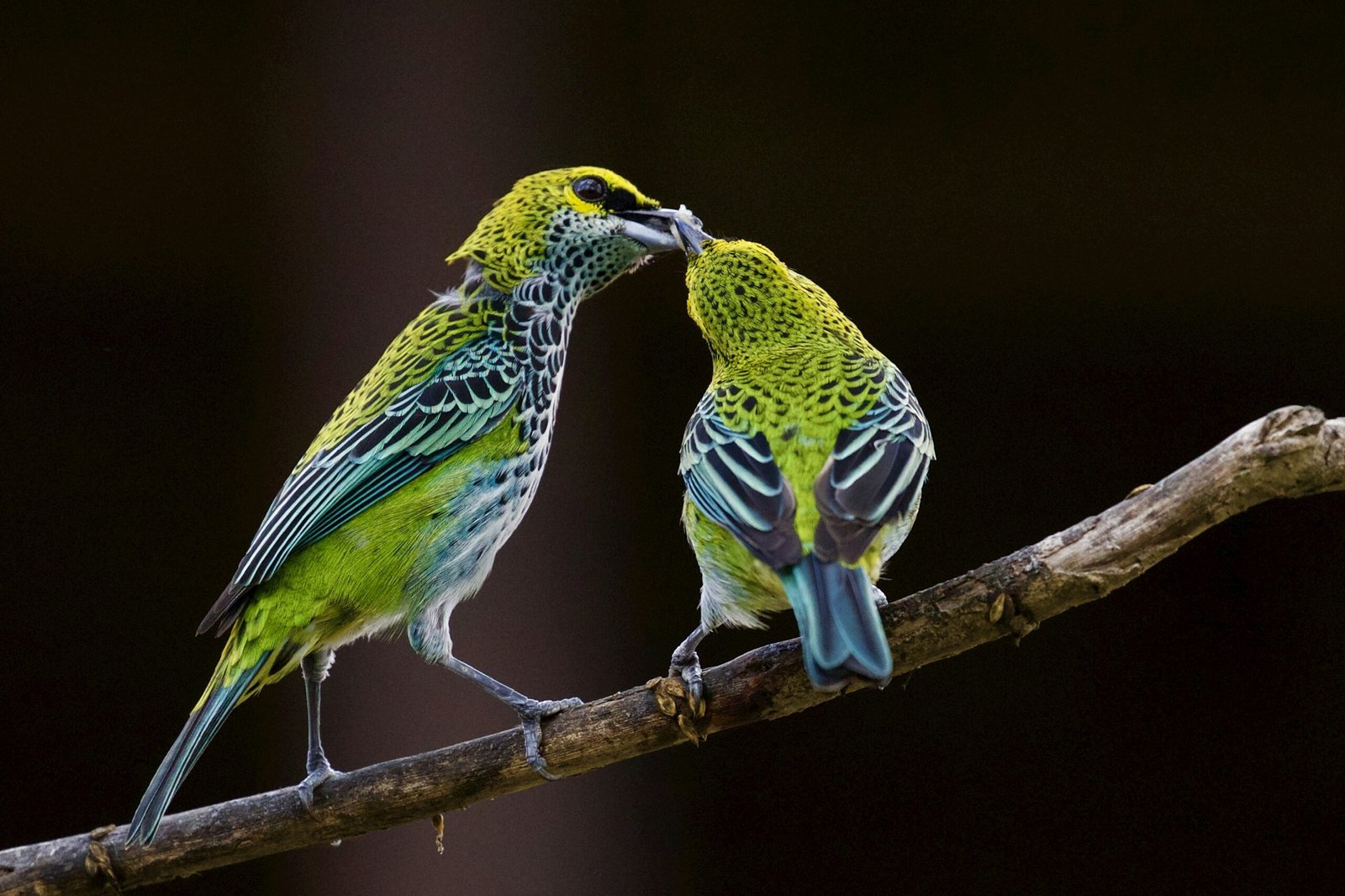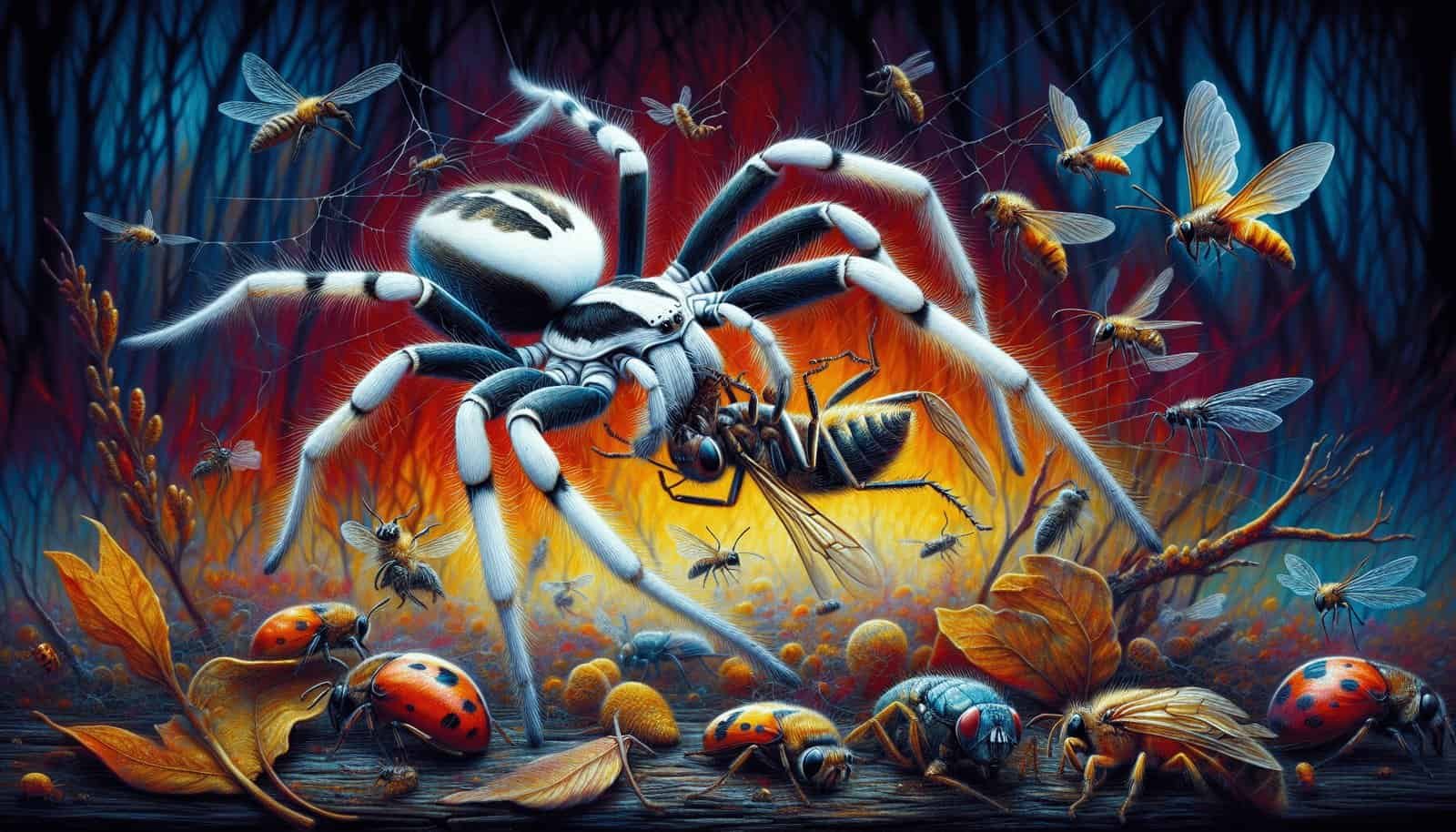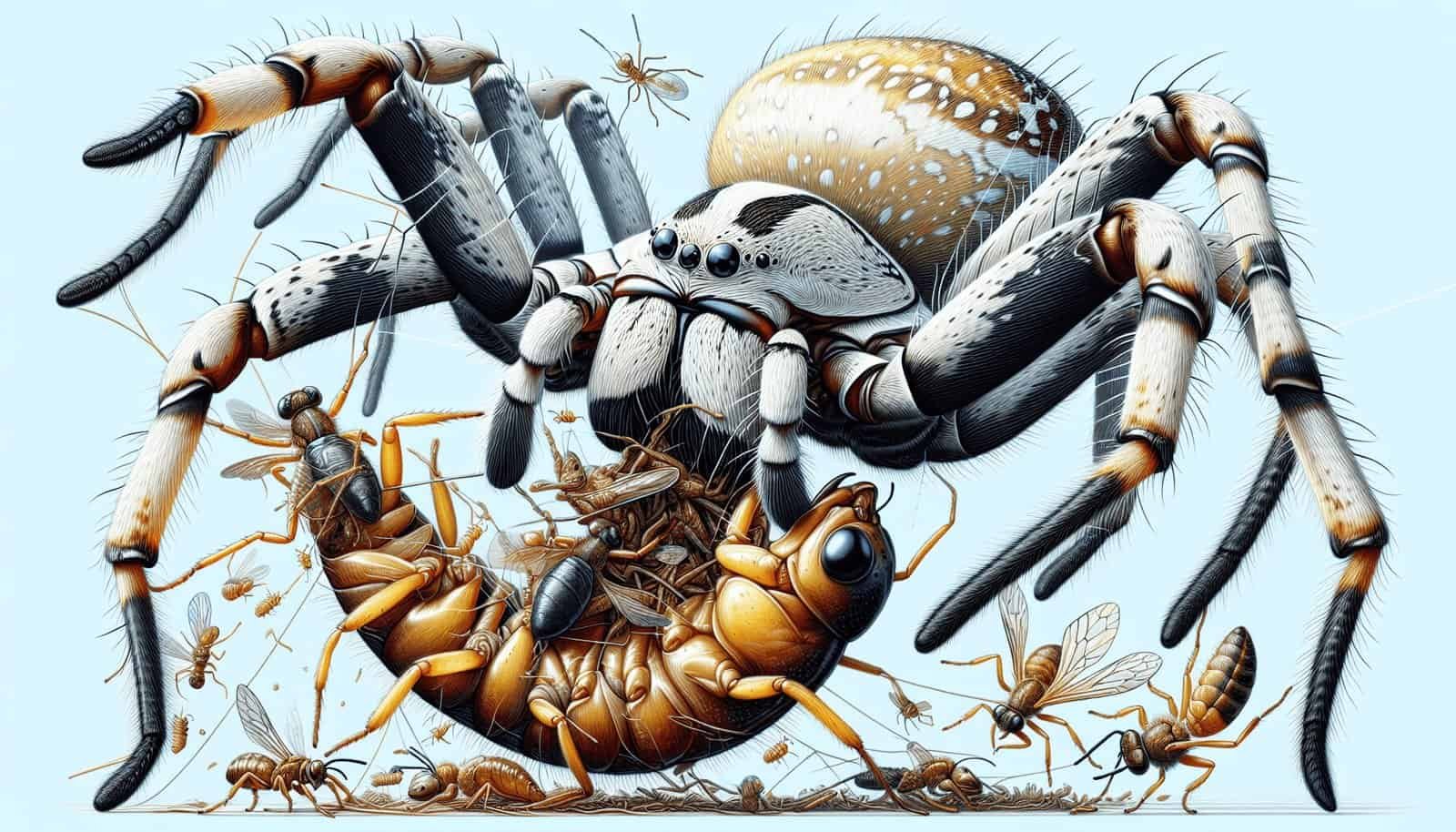Have you ever wondered how the visually stunning white-tailed spider feeds and what types of prey it prefers? In this article, we will explore the feeding behavior of this captivating arachnid and discuss the prey items that are suitable for its survival. As one of the most visually striking spiders, the white-tailed spider has gained attention for both its beauty and its potential danger to humans. So, let’s embark on a journey into the world of this fascinating creature and uncover the mysteries of its feeding habits.
An Introduction to the White-tailed Spider
Welcome to this comprehensive guide on the feeding behavior of the white-tailed spider! In this article, we will delve into the fascinating world of these visually stunning arachnids and explore their feeding habits. We will also uncover the prey items that are suitable for these spiders and discuss their characteristics. Additionally, we will take a look at some common and unusual prey items of the white-tailed spider, as well as their hunting techniques and the feeding process. Finally, we will touch upon the potential impact of these spiders on pest control and highlight the importance of understanding their feeding behavior. Let’s get started!
Description
The white-tailed spider, scientifically known as Lampona cylindrata, is a native spider species found in various parts of Australia. These spiders are easily recognized by their sleek body and distinctive white tip at the end of their abdomen. Their elongated legs and dark reddish-brown coloring add to their unique appearance. White-tailed spiders are relatively small, with females growing up to 18 millimeters in length, while males are usually smaller, measuring around 12 millimeters. Despite their fearsome reputation, these spiders are not considered dangerous to humans.
Habitat
White-tailed spiders can be found in a range of habitats, including gardens, forests, and urban areas. They are commonly seen in and around homes, especially in dark and sheltered places such as under bark, logs, or rocks. These spiders are also known to seek refuge indoors, particularly in cool and damp areas like basements or bathrooms. Their adaptability to different environments allows them to thrive in various locations throughout their distribution range.
Distribution
The distribution of white-tailed spiders primarily encompasses Australia, with sightings reported in all states and territories. They are particularly abundant along the eastern coast and are commonly found in New South Wales, Queensland, Victoria, and Tasmania. While their range extends across large parts of the continent, their populations are more concentrated in coastal regions. The ability of white-tailed spiders to inhabit diverse habitats has contributed to their wide distribution across Australia.
Feeding Behavior of the White-tailed Spider
Carnivorous Diet
As carnivores, white-tailed spiders feed exclusively on other animals. Their diet primarily consists of a variety of small insects and other arthropods. These spiders are skilled hunters and employ various techniques to capture their prey.
Ambush Predators
White-tailed spiders are accomplished ambush predators. They rely on their excellent vision and agility to stalk and strike unsuspecting prey. These spiders often wait patiently in strategic locations for their prey to come within reach. Once within striking distance, they lunge forward with lightning speed, immobilizing their victim with a venomous bite.
Nocturnal Hunting
White-tailed spiders are primarily nocturnal hunters. They are most active during the night, using the cover of darkness to their advantage. Their keen sense of sight allows them to navigate and locate prey in low-light conditions. This nocturnal behavior plays a crucial role in their survival and successful hunting.
Prey Items for the White-tailed Spider
Insects
Insects are a significant component of the white-tailed spider’s diet. These spiders target a wide range of insects, including cockroaches, crickets, beetles, and flies. The small size and abundance of insects make them attractive prey items for white-tailed spiders. Their agility and speed give them an advantage in capturing these swift-moving targets.
Other Arthropods
White-tailed spiders also feed on various other arthropods. This includes creatures such as millipedes, centipedes, and harvestmen. These arthropods are typically found in similar habitats as the white-tailed spider and often fall victim to their predatory instincts.
Small Spiders
Despite their relatively small size, white-tailed spiders are not averse to preying on other spiders. They are known to attack and consume smaller spider species that cross their path. This intraspecific predation highlights the predatory nature and adaptability of white-tailed spiders.
Characteristics of Suitable Prey Items
Size
The size of the prey item plays a crucial role in the spider’s ability to capture and consume it. White-tailed spiders tend to target prey that is smaller in size compared to them. This size preference ensures that the spider can overpower its victim efficiently.
Activity Level
Prey items that exhibit high activity levels are more likely to attract the attention of white-tailed spiders. The spiders are skilled at detecting movement and are quick to respond to potential prey that displays heightened activity. This preference for active prey increases the spider’s chances of successfully capturing its meal.
Web-building Behavior
The web-building behavior of certain insect species can also make them suitable prey for white-tailed spiders. Spiders that construct intricate webs often inadvertently attract the attention of these predators. As the white-tailed spider navigates its environment, it may chance upon a web and seize the opportunity to strike at the unsuspecting occupant.

Common Prey of the White-tailed Spider
Cockroaches
Cockroaches are a common prey item for white-tailed spiders. These insects can often be found in dark and damp areas, which coincides with the preferred habitat of the spider. The stealth and agility of white-tailed spiders make them adept hunters of these elusive and quick pests.
Crickets
Crickets are another favored prey for white-tailed spiders. With their hopping and chirping behavior, crickets attract the attention of these arachnids. The spider’s pouncing technique is particularly effective in capturing these insects as they move about.
Silverfish
Silverfish are small, wingless insects that are often found in homes. Their structure and behavior make them an ideal meal for the white-tailed spider. These spiders are known to inhabit areas where silverfish are commonly found, and their stealthy hunting techniques ensure successful encounters.
Unusual Prey Items of the White-tailed Spider
Other Spiders
While not as common, white-tailed spiders have been observed preying on other spider species. This intraspecific predation can occur when smaller spiders inadvertently cross paths with their larger counterparts. White-tailed spiders do not discriminate against other spiders when it comes to finding a meal.
Scorpions
In rare cases, white-tailed spiders have been known to prey on scorpions. Scorpions possess venomous stingers, making them formidable opponents. However, white-tailed spiders are equipped with their own venomous bite and have the speed and agility to subdue these arachnids.
Small Lizards
Although relatively uncommon, white-tailed spiders have been documented feeding on small lizards. Their strong jaws and venomous bite enable them to overpower these reptiles. Given the opportunity, white-tailed spiders can even tackle larger prey items, showcasing their adaptability and hunting prowess.
Hunting Techniques of the White-tailed Spider
Web-based Hunting
White-tailed spiders engage in web-based hunting when they come across an occupied web. Rather than waiting for the occupant to come to them, these spiders will actively investigate the web, assessing the size and potential threat. Once deemed suitable, they will strike and immobilize the trapped prey.
Active Hunting
White-tailed spiders are highly active hunters, employing their superb vision and agility to actively pursue and capture prey. They will meticulously track their target, adapting their movement and speed as necessary. This strategy allows them to effectively close the distance between themselves and their intended meal.
Ambushing from Shelters
These spiders are skilled at ambushing their prey from various shelters. They will position themselves strategically in dark corners, under rocks, or within crevices, patiently awaiting an unsuspecting victim. With their exceptional speed, they can quickly lunge and immobilize the prey caught off guard.
Feeding Process of the White-tailed Spider
Bite and Envenomation
Once the white-tailed spider captures its prey, it delivers a venomous bite to immobilize it. The venom of these spiders contains a potent mixture of toxins that paralyze the prey and begin breaking down its internal tissues. This venomous bite is a crucial step in preparing the captured prey for consumption.
Predigestion
After envenomation, the white-tailed spider engages in predigestion. It injects digestive enzymes into the prey’s body, which starts breaking down the internal tissues into a more easily consumable form. This predigestion process allows the spider to extract the nutrients efficiently.
Consumption
Once the prey has been sufficiently predigested, the white-tailed spider begins consuming it. These spiders have powerful jaws and fangs that enable them to tear through the exoskeleton or outer shell of the prey. They then ingest the liquefied internal tissues, extracting vital nutrients to fuel their own growth and survival.

Potential Impact on Pest Control
Natural Pest Control Agent
White-tailed spiders play a significant role in natural pest control. Their dietary preferences, especially for insects and other arthropods, make them valuable allies in keeping populations of such pests in check. By targeting and feeding on pests that can cause damage or pose health risks to humans, these spiders contribute to maintaining a balanced ecosystem.
Effectiveness in Controlling Insects
The effectiveness of white-tailed spiders in controlling insect populations can vary depending on factors such as prey availability and habitat suitability. While they can provide valuable pest control assistance, their impact may not be sufficient to eradicate pests entirely. Nonetheless, their presence and predation on insect pests can help in reducing their numbers and minimizing potential pest-related issues.
Role in Ecosystem
White-tailed spiders occupy an important niche in the ecosystem as predators. By preying on various insects, other arthropods, and occasionally other spiders, they help regulate the populations of these organisms. This contributes to the overall balance and stability of the ecosystem, supporting the biodiversity of their habitats.
Conclusion
Understanding the feeding behavior of the white-tailed spider is essential in appreciating its role in nature. These visually stunning arachnids are fascinating creatures with unique hunting techniques and a diverse range of prey items. From insects to other spiders and even small lizards, these spiders display adaptability and skill in capturing their meals. Through their role in pest control and contributing to ecosystem balance, white-tailed spiders have earned their place in the natural world. Further research opportunities lie ahead to expand our knowledge of these captivating creatures and their interactions within their environment. By studying their feeding behavior, we can gain a deeper understanding and foster an appreciation for the intricate workings of our natural world.


